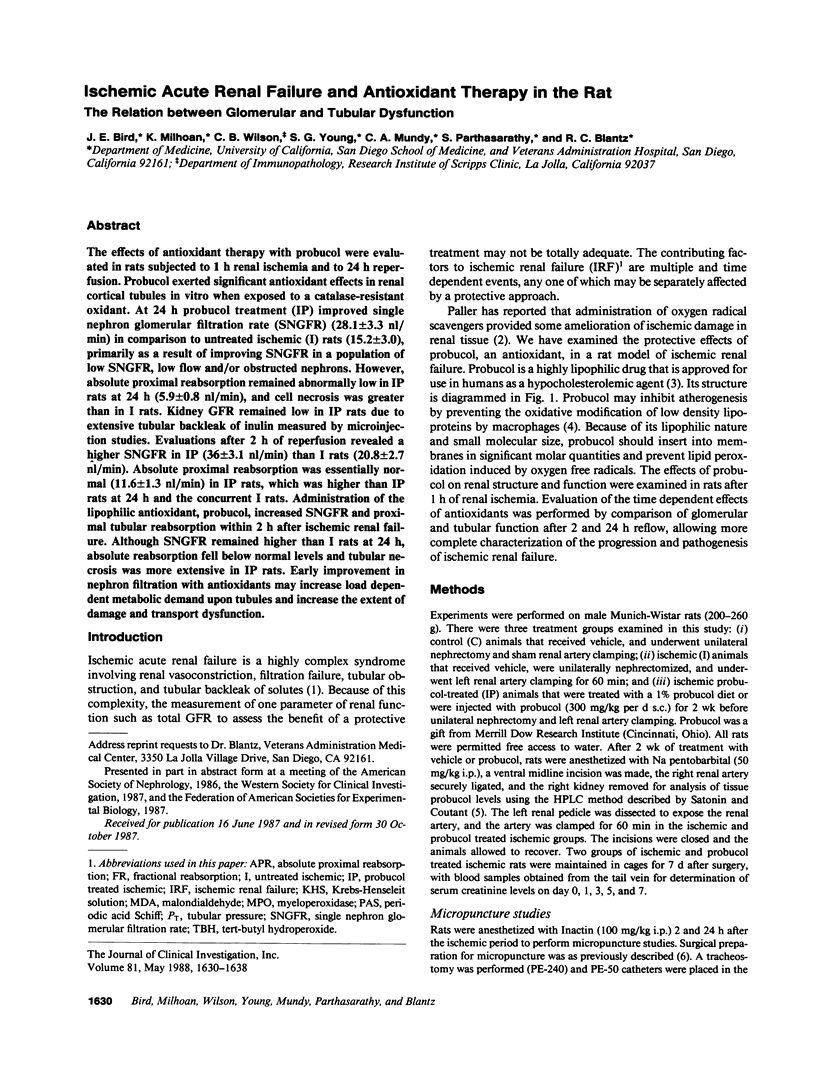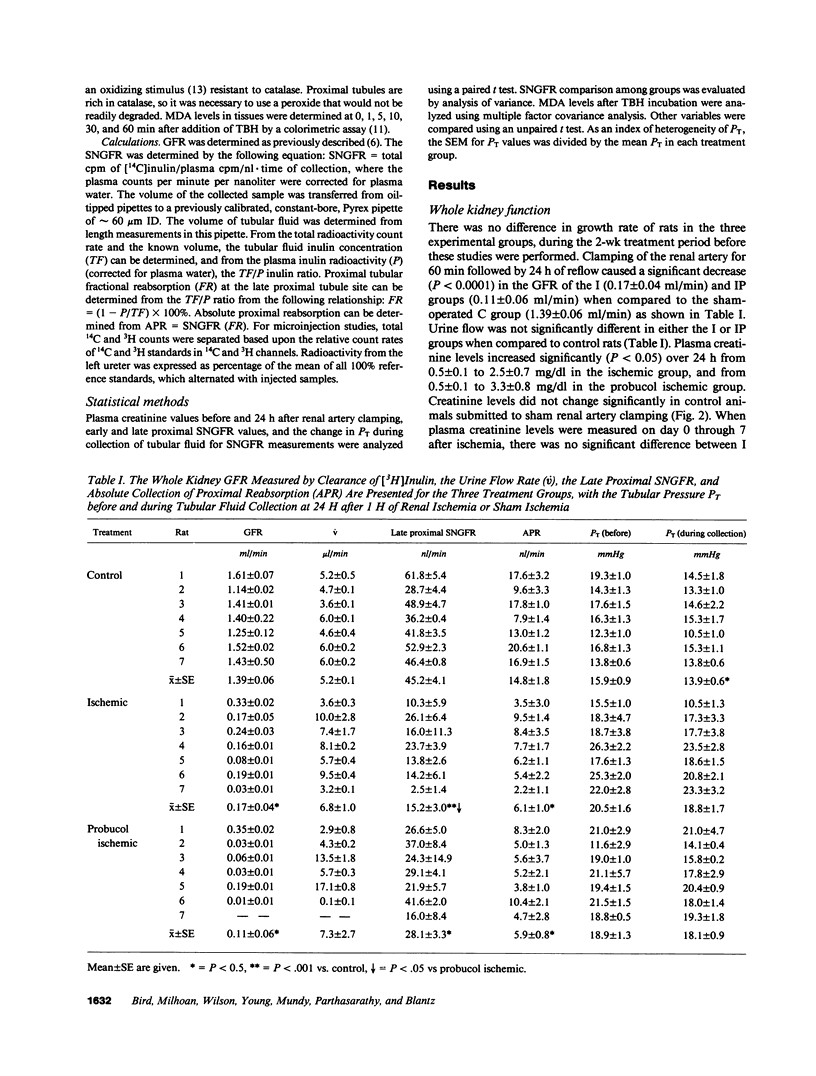Abstract
The effects of antioxidant therapy with probucol were evaluated in rats subjected to 1 h renal ischemia and to 24 h reperfusion. Probucol exerted significant antioxidant effects in renal cortical tubules in vitro when exposed to a catalase-resistant oxidant. At 24 h probucol treatment (IP) improved single nephron glomerular filtration rate (SNGFR) (28.1 +/- 3.3 nl/min) in comparison to untreated ischemic (I) rats (15.2 +/- 3.0), primarily as a result of improving SNGFR in a population of low SNGFR, low flow and/or obstructed nephrons. However, absolute proximal reabsorption remained abnormally low in IP rats at 24 h (5.9 +/- 0.8 nl/min), and cell necrosis was greater than in I rats. Kidney GFR remained low in IP rats due to extensive tubular backleak of inulin measured by microinjection studies. Evaluations after 2 h of reperfusion revealed a higher SNGFR in IP (36 +/- 3.1 nl/min) than I rats (20.8 +/- 2.7 nl/min). Absolute proximal reabsorption was essentially normal (11.6 +/- 1.3 nl/min) in IP rats, which was higher than IP rats at 24 h and the concurrent I rats. Administration of the lipophilic antioxidant, probucol, increased SNGFR and proximal tubular reabsorption within 2 h after ischemic renal failure. Although SNGFR remained higher than I rats at 24 h, absolute reabsorption fell below normal levels and tubular necrosis was more extensive in IP rats. Early improvement in nephron filtration with antioxidants may increase load dependent metabolic demand upon tubules and increase the extent of damage and transport dysfunction.
Full text
PDF








Images in this article
Selected References
These references are in PubMed. This may not be the complete list of references from this article.
- Andrews P. C., Krinsky N. I. Quantitative determination of myeloperoxidase using tetramethylbenzidine as substrate. Anal Biochem. 1982 Dec;127(2):346–350. doi: 10.1016/0003-2697(82)90185-3. [DOI] [PubMed] [Google Scholar]
- Arendshorst W. J., Finn W. F., Gottschalk C. W. Pathogenesis of acute renal failure following temporary renal ischemia in the rat. Circ Res. 1975 Nov;37(5):558–568. doi: 10.1161/01.res.37.5.558. [DOI] [PubMed] [Google Scholar]
- Barnes J. L., Osgood R. W., Reineck H. J., Stein J. H. Glomerular alterations in an ischemic model of acute renal failure. Lab Invest. 1981 Oct;45(4):378–386. [PubMed] [Google Scholar]
- Barnhart J. W., Rytter D. J., Molello J. A. An overview of the biochemical pharmacology of probucol. Lipids. 1977 Jan;12(1):29–33. doi: 10.1007/BF02532968. [DOI] [PubMed] [Google Scholar]
- Brezis M., Rosen S., Silva P., Epstein F. H. Transport activity modifies thick ascending limb damage in the isolated perfused kidney. Kidney Int. 1984 Jan;25(1):65–72. doi: 10.1038/ki.1984.9. [DOI] [PubMed] [Google Scholar]
- Conger J. D., Robinette J. B., Kelleher S. P. Nephron heterogeneity in ischemic acute renal failure. Kidney Int. 1984 Oct;26(4):422–429. doi: 10.1038/ki.1984.191. [DOI] [PubMed] [Google Scholar]
- Donohoe J. F., Venkatachalam M. A., Bernard D. B., Levinsky N. G. Tubular leakage and obstruction after renal ischemia: structural-functional correlations. Kidney Int. 1978 Mar;13(3):208–222. doi: 10.1038/ki.1978.31. [DOI] [PubMed] [Google Scholar]
- Fantone J. C., Ward P. A. Role of oxygen-derived free radicals and metabolites in leukocyte-dependent inflammatory reactions. Am J Pathol. 1982 Jun;107(3):395–418. [PMC free article] [PubMed] [Google Scholar]
- Finn W. F. Nephron heterogeneity in polyuric acute renal failure. J Lab Clin Med. 1981 Jul;98(1):21–29. [PubMed] [Google Scholar]
- LOWRY O. H., ROSEBROUGH N. J., FARR A. L., RANDALL R. J. Protein measurement with the Folin phenol reagent. J Biol Chem. 1951 Nov;193(1):265–275. [PubMed] [Google Scholar]
- Ohkawa H., Ohishi N., Yagi K. Assay for lipid peroxides in animal tissues by thiobarbituric acid reaction. Anal Biochem. 1979 Jun;95(2):351–358. doi: 10.1016/0003-2697(79)90738-3. [DOI] [PubMed] [Google Scholar]
- Paller M. S., Hoidal J. R., Ferris T. F. Oxygen free radicals in ischemic acute renal failure in the rat. J Clin Invest. 1984 Oct;74(4):1156–1164. doi: 10.1172/JCI111524. [DOI] [PMC free article] [PubMed] [Google Scholar]
- Parthasarathy S., Young S. G., Witztum J. L., Pittman R. C., Steinberg D. Probucol inhibits oxidative modification of low density lipoprotein. J Clin Invest. 1986 Feb;77(2):641–644. doi: 10.1172/JCI112349. [DOI] [PMC free article] [PubMed] [Google Scholar]
- Rehan A., Johnson K. J., Kunkel R. G., Wiggins R. C. Role of oxygen radicals in phorbol myristate acetate-induced glomerular injury. Kidney Int. 1985 Mar;27(3):503–511. doi: 10.1038/ki.1985.39. [DOI] [PubMed] [Google Scholar]
- Satonin D. K., Coutant J. E. Comparison of gas chromatography and high-performance liquid chromatography for the analysis of probucol in plasma. J Chromatogr. 1986 Aug 2;380(2):401–406. doi: 10.1016/s0378-4347(00)83670-1. [DOI] [PubMed] [Google Scholar]
- Tanner G. A., Steinhausen M. Tubular obstruction in ischemia-induced acute renal failure in the rat. Kidney Int Suppl. 1976 Oct;6:S65–S73. [PubMed] [Google Scholar]
- Weiss S. J., Ward P. A. Immune complex induced generation of oxygen metabolites by human neutrophils. J Immunol. 1982 Jul;129(1):309–313. [PubMed] [Google Scholar]








